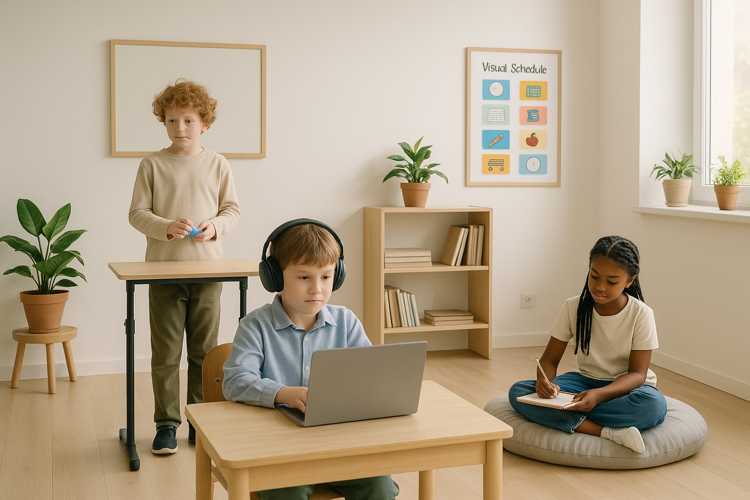Progress Tracking That Actually Helps Neurodivergent Learners Grow
Image made with AI (DALL-E)
Discover flexible, personalized progress tracking methods that work with neurodivergent brains—not against them. Learn assessment alternatives to rigid grading systems.
Progress Tracking That Actually Helps Neurodivergent Learners Grow
Let's be honest: traditional grades are about as helpful for neurodivergent learners as a screen door on a submarine. You know what I'm talking about—those red-penned report cards that measure everyone against the same arbitrary timeline, completely ignoring that some brains work more like jazz improvisation than classical music.
Here's the thing: a "C" doesn't tell you anything meaningful about a dyslexic student who just figured out their own reading strategy, or an ADHD learner who finally cracked a focus technique that works. It just tells you they didn't perform like the mythical "average student" on test day.
But what if progress tracking could actually help neurodivergent learners grow instead of just ranking them? What if we measured what actually matters—like effort, strategy development, and genuine skill building? Stick with me, because we're about to flip the script on how we think about learning metrics.
Why Traditional Grades Fail Neurodivergent Brains
Standard grading systems were designed for brains that develop in predictable, linear patterns. Newsflash: neurodivergent brains didn't get that memo.
The non-linear learning problem is real. A student with ADHD might hyperfocus and master an entire unit in three days, then struggle to complete a simple worksheet the following week. An autistic learner might demonstrate incredible expertise verbally but freeze during written tests. Dyslexic students often show problem-solving brilliance that never shows up on timed assessments.
Traditional grades capture a single moment—usually the worst possible format for that particular brain—and call it "progress." That's not measurement; that's a setup for failure.
The reality check: Research shows neurodivergent learners often have spiky skill profiles—exceptional in some areas, challenged in others. Letter grades flatten this complexity into useless averages.
What Personalized Progress Tracking Actually Looks Like
Forget everything you think you know about "tracking." We're not talking about surveillance or micromanagement here.
Focus on Growth, Not Comparison
Personalized learning metrics for neurodivergent students measure the individual against themselves—not against their classmates or some standardized benchmark that makes no sense for their brain.
This means tracking things like: - Strategy development: Did they discover a new approach that works for them? - Effort consistency: Are they showing up and trying, even when it's hard? - Skill accumulation: What can they do now that they couldn't do three weeks ago?
An ADHD student might track improvements in focus duration (5 minutes to 15 minutes of sustained attention). A dyslexic learner might measure their growing confidence with verbal presentations while adjusting written assignment expectations. These are real metrics that matter to real growth.
Multi-Modal Evidence Collection
Here's where it gets fun (I promise, as fun as assessment can be). Flexible assessment alternatives to grades don't rely on just one method of showing knowledge.
Portfolio-based assessment lets students collect evidence of learning over time—completed projects, creative work, video demonstrations, even conversations about what they learned. It's like Instagram for education, except actually useful.
Example scenario: Instead of a traditional book report, a student might create a podcast episode discussing themes, record themselves building a diorama while explaining symbolism, or write a sequel chapter that demonstrates comprehension. Same learning goals, different pathways.
The beauty? You're measuring actual understanding and application, not just test-taking ability.
The Strength-Based Tracking Revolution
Let's talk about something that'll blow your mind: what if we spent as much energy documenting what neurodivergent learners do well as we spend highlighting their struggles?
Building on Interests and Natural Abilities
Strengths-based assessment for neurodivergent students flips the traditional deficit-focused model on its head. Instead of constantly pointing out what's "wrong," we track capability building.
This doesn't mean ignoring growth areas (let's be real, we all have them). It means starting from a foundation of competence and building outward.
When an autistic student shows deep expertise in their special interest area, that becomes the anchor point for developing related skills. An ADHD learner's creativity and quick thinking become assets to develop, not distractions to suppress.
Low-Pressure Progress Monitoring Methods
Here's a secret: the best tracking system is the one that actually gets used.
Neurodivergent brains often struggle with executive function challenges—which means your progress tracking method can't add another layer of stress. If checking in on goals feels like a punishment, nobody's using it.
Effective low-stakes monitoring includes: - Quick weekly pulse checks (5 minutes, tops) - Visual tracking tools like habit charts or apps with minimal text - Self-assessment prompts instead of formal evaluations - Celebrating small wins before discussing improvements
Think of it as checking your GPS during a road trip, not submitting to a full vehicle inspection every ten miles.
How to Create a Personalized Progress Tracking System
Alright, enough theory—let's build something practical. Here's your step-by-step guide to customized progress tracking that doesn't make everyone miserable.
Step 1: Assess Current Comfort and Preferences
Start by asking the learner what they actually want. Revolutionary, I know.
Find out their preferred tracking format—do they love digital apps, or does a simple paper chart feel less overwhelming? Are they visual learners who need color-coded systems, or do they prefer straightforward checklists?
Pro tip: If a student has tracking trauma from past experiences, acknowledge that upfront. This is a fresh start.
Step 2: Collaboratively Identify Meaningful Goals
Notice that word "collaboratively"? It's doing heavy lifting here.
Choose 2-3 goals together—not 47, because that's how you create instant overwhelm and abandonment. Make sure these goals connect to the learner's interests and strengths, not just academic requirements.
For an ADHD student, a goal might be "develop one focus strategy that works for me." For a dyslexic learner: "find three ways to show my understanding without traditional writing."
Step 3: Define Observable, Flexible Metrics
This is where mastery-based tracking for autistic learners and other neurodivergent students shines. Make your metrics concrete enough to recognize progress, but flexible enough to accommodate real life.
Instead of "complete all homework on time" (rigid, sets up failure), try "identify and use productivity strategies 3 times per week" (flexible, celebrates effort).
Step 4: Choose a Low-Maintenance Method
Remember: friction is the enemy. If your tracking system requires a 30-minute setup every week, it's already dead.
Simple options include: - A one-page habit tracker with checkboxes - A shared document with weekly reflections - Photos of completed work in a dedicated folder - Voice notes recording thoughts and wins
The best system? The one the student will actually use without nagging.
Step 5: Establish Regular Brief Check-Ins
Weekly or bi-weekly touchpoints keep everyone accountable without creating dread. These aren't interrogations—they're conversations.
"What went well this week? What was challenging? What do you want to try next week?"
That's it. You're done. Gold star for everyone.
Step 6: Celebrate Wins and Adjust Expectations
Here's where growth-based evaluation for neurodivergent students gets magical: you acknowledge reality while celebrating progress.
Did the student only complete one of three goals because their anxiety was high this week? Cool—let's celebrate the one they did do and talk about adjusting next week's expectations.
This teaches self-awareness, self-advocacy, and realistic planning—skills worth far more than any letter grade.
Step 7: Build in Accommodation Reviews
Life changes. Energy levels fluctuate. Executive function comes and goes like a flaky friend.
Monthly reviews let you adjust tracking expectations based on what's actually happening. Maybe the visual chart isn't working anymore and you need to try an app. Maybe three goals were too ambitious and two feels better.
Flexibility isn't failure—it's responsive teaching.
Common Pitfalls to Avoid (Because We've All Been There)
Even with the best intentions, progress tracking can go sideways. Here's what to watch for.
Mistake #1: Using identical metrics for every student. Individualized learning goals for neurodivergent students aren't optional—they're essential. What works for one ADHD learner might be completely wrong for another.
Mistake #2: Creating overwhelm with too many data points. Decision fatigue is real, especially for neurodivergent brains. Three meaningful metrics beat fifteen forgotten ones.
Mistake #3: Focusing only on deficits. If your tracking system only highlights what's going wrong, you've built a shame generator, not a growth tool. Balance is everything.
Mistake #4: Rigid timelines that ignore energy fluctuations. Burnout cycles, sensory overload days, and medication adjustments all affect learning capacity. Your tracking system needs to acknowledge this reality.
Frequently Asked Questions
How do personalized metrics prevent 'teaching to the test' syndrome?
When you're measuring genuine skill development instead of standardized test performance, the incentive structure changes completely. Individualized metrics focus on what the student can actually do—apply knowledge, solve problems, create something meaningful—rather than memorize test-specific content.
Plus, neurodivergent learning assessment strategies that emphasize process and growth naturally encourage deeper learning. You can't fake mastering a new focus technique or developing a personal reading strategy.
Won't flexible standards let neurodivergent learners avoid challenge?
Here's the counterintuitive truth: research consistently shows that neurodivergent learners tackle harder challenges when they feel less shame about their pace and process.
Flexibility in how progress is measured doesn't mean lowering expectations—it means providing different pathways to competency. An autistic student demonstrating expertise through a detailed video presentation instead of an essay? That might actually be more challenging and showcase deeper understanding.
How do I track progress for non-linear learners with good and bad weeks?
Trend-spotting over time is your friend. Instead of comparing week-to-week performance (which will drive everyone crazy), look at monthly or quarterly patterns.
Did focus strategies improve over the semester, even if there were rough weeks? Did the student's self-awareness about their learning needs grow? Those are the meaningful metrics.
Key principle: Track effort and strategy consistency regardless of output quality. Some weeks, just showing up is the win.
Can personalized metrics work in formal educational settings with grade requirements?
Absolutely. Here's the secret: detailed progress documentation and portfolio evidence can justify grades more defensibly than traditional testing alone.
When you can show a student's skill mastery through multiple forms of evidence—self-assessments, project work, growth over time—you're actually building a stronger case for grades than "they got a 73% on the midterm."
Many teachers use alternative grading rubrics for neurodivergent learners to inform traditional letter grades while maintaining individualized tracking internally.
What if a neurodivergent learner doesn't want to be tracked at all?
Respect that autonomy, full stop. Then get curious about why.
Often, tracking resistance comes from shame history, previous experiences with punitive monitoring, or control issues. If you can identify the "why," you can offer alternatives.
Some students respond better to minimal-burden options like weekly strength journals, casual verbal check-ins, or creative self-reflection prompts. The goal is supporting growth, not forcing compliance.
Rethinking What "Progress" Really Means
Here's the uncomfortable truth: traditional grading systems were never designed to capture the full picture of neurodivergent learning. They measure compliance, timing, and standardized performance—not actual capability development.
When we shift to personalized progress tracking for neurodivergent learners, we're not making things "easier." We're making measurement more accurate. We're documenting genuine growth instead of ranking students against arbitrary benchmarks.
The best progress tracking methods for dyslexic learners, ADHD students, autistic individuals, and other neurodivergent brains all share one thing: they work with different neurotypes, not against them.
Three key takeaways:
- Effective tracking focuses on individual growth, strategy development, and strengths—not comparison to standardized benchmarks
- Low-friction, flexible systems accommodate neurodivergent energy fluctuations and executive function challenges
- Co-creating metrics with learners builds self-awareness and motivation far better than imposed grading systems
Ready to ditch the red pen and build something better? Start small. Pick one learner. Try one flexible metric. See what happens when progress tracking becomes a tool for growth instead of a weapon of measurement.
Your neurodivergent learners (and honestly, probably all your learners) will thank you. And who knows? You might actually enjoy assessment season for once. Stranger things have happened.
Links marked with an asterisk (*) are affiliate links to external offers. If you click on such a link and make a purchase through it, we receive a commission from the provider. The price does not change for you.
Related Articles

The Science Behind Short Attention Spans and How to Work With Them
Discover the neuroscience of attention in ADHD and autism, plus practical classr...
9 min read
From Frustration to Fun - Turning Writing Practice Into Play
Discover game-based writing exercises that transform reluctant writers into eage...
9 min read
Building Reading Confidence Through Multisensory Activities That Actually Work
Discover research-backed hands-on reading techniques using touch, sound, and mov...
10 min read
Creating a Calm Learning Space at Home - A Parent's Guide to Better Focus
Discover how lighting, sound, temperature, and texture impact your child's focus...
13 min read
